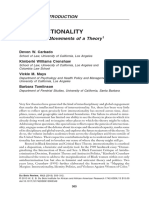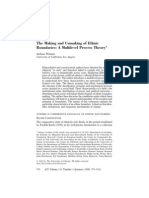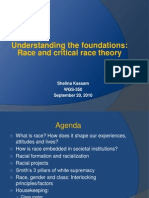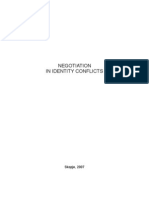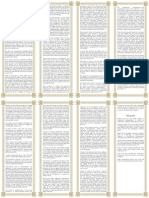Handout2 Intersect Sweden11
Handout2 Intersect Sweden11
Uploaded by
Katie KingCopyright:
Available Formats
Handout2 Intersect Sweden11
Handout2 Intersect Sweden11
Uploaded by
Katie KingOriginal Title
Copyright
Available Formats
Share this document
Did you find this document useful?
Is this content inappropriate?
Copyright:
Available Formats
Handout2 Intersect Sweden11
Handout2 Intersect Sweden11
Uploaded by
Katie KingCopyright:
Available Formats
Handout 2 King, Workshop Online: “Social Media Learning,” http://socmedlearn.blogspot.
com/
Linköping University, Sweden, 29-30 March 2011
transversal intersectionalities
Katie King, Women's Studies, University of Maryland, College Park/Email: katking@umd.edu
Home Page: http://katiekin.weebly.com/ Twitter: @katkingumd; in Second Life: Katie Fenstalker
“With identity thus re-conceptualized, it may be easier to understand the need for, and
to summon the courage to challenge, groups, that are after all, in one sense, 'home' to
us, in the name of the parts of us that are not made at home. This takes a great deal of
energy, and arouses intense anxiety. The most one could expect is that we will dare to
speak against internal exclusions and marginalizations, that we might call attention to
how the identity of 'the group' has been centered on the intersectional identities of a
few. Recognizing that identity politics takes place at the site where categories intersect
thus seems more fruitful than challenging the possibility of talking about categories at
all. Through an awareness of intersectionality, we can better acknowledge and ground
the differences among us and negotiate the means by which these differences will find
expression in constructing group politics." (Crenshaw, 1991: 1299)
References:
• Crenshaw, K. (1991). “Mapping the Margins: Intersectionality, Identity Politics.” Stanford Law Review 43/6, 1241-1299.
• Gordon, A. (1997). Ghostly Matters: Haunting and the Sociological Imagination. Minnesota.
• Bowker, G. C., & Star, S. L. (1999). Sorting things out: classification and its consequences. Cambridge: MIT.
• Collin, P.H. (2000). 2nd. Ed. Black Feminism Thought. Routledge.
• Sandoval, C. (2000). Methodology of the Oppressed. Minnesota.
• Somerville, S. (2005). “Queer Loving.” GLQ: A Journal of Lesbian and Gay Studies 11/3, 335-70.
• Yuval-Davis, N. (2006). “Intersectionality and Feminist Politics.” European Journal of Women’s Studies 13/3, 193-209. Rep.
in Berger, M. (2009). The intersectional approach: transforming the academy through race, class, and gender. UNC.
• Davis, K. (2008). “Intersectionality as buzzword.” Feminist Theory vol. 9/1, 67–85.
POWER AND COMPLEX PERSONHOOD (Gordon 1997: 3-4)
“That life is complicated may seem a banal expression of the obvious, but it is nonetheless a profound theoretical
statement—perhaps the most important theoretical statement of our time… even those who live in the most dire
circumstances possess a complex and oftentimes contradictory humanity and subjectivity that is never adequately
glimpsed by viewing them as victims or, on the other hand, as superhuman agents. It has always baffled me why
those most interested in understanding and changing the barbaric domination that characterizes our modernity
often—not always—withhold from the very people they are most concerned with the right to complex personhood.
Complex personhood is the second dimension of the theoretical statement that life is complicated. Complex
personhood means that all people (albeit in specific forms whose specificity is sometimes everything) remember and
forget, are beset by contradiction, and recognize and misrecognize themselves and others. Complex personhood
means that people suffer graciously and selfishly too, get stuck in the symptoms of their troubles, and also transform
themselves. Complex personhood means that even those called ‘Other’ are never never that…. Complex personhood
means that groups of people will act together, that they will vehemently disagree with and sometimes harm each
other, and that they will do both at the same time and expect the rest of us to figure it out for ourselves, intervening
and withdrawing as the situation requires…. That life is complicated is a theoretical statement that guides efforts to
treat race, class, and gender dynamics and consciousness as more dense and delicate than those categorical terms
often imply.”
A MATRIX OF DOMINATION (Collins 2000: 227-8; 246, 247-8):
“Intersectional paradigms…shed new light on how domination is organized. The term matrix of domination describes
this overall social organization within which intersecting oppressions originate, develop, and are contained…. In a
particular form assumed by intersecting oppressions in one social location, any matrix of domination can be seen as
an historically specific organization of power in which social groups are embedded and which they aim to influence….
All contexts of domination incorporate some combination of intersecting oppressions, and considerable variability
exists from one matrix of domination to the next as to how oppression and activism will be organized…. Placing U.S.
Black women’s experiences in the center of analysis without privileging those experiences shows how intersectional
paradigms can be especially important for rethinking the particular matrix of domination that characterizes U.S.
society…. (227-8) Within any matrix of domination characterized by intersecting oppressions, any specific social
location where such systems meet or intersect generates distinctive group histories. (246) …moral positions as
survivors of one expression of systemic violence become eroded in the absence of accepting responsibility for other
expressions of systemic violence. (247) …In this model, there are no absolute oppressors or victims. Instead,
historically constructed categories create intersecting and crosscutting group histories that provide changing patterns
of group participation in domination and resistance to it…. Coalitions ebb and flow based on the perceived saliency of
issues to group members. This non-equivalency of group experience means that groups find some oppressions more
salient than others….whereas all systems operate in framing the experiences of Black women transnationally, different
configurations of such systems has saliency for Black women differently placed within them.” (248)
DEMOCRATIZATION OF OPPRESSION AND DIFFERENTIAL CONSCIOUSNESS (Sandoval 2000: 36, 83)
"There has been an upheaval under neocolonializing postmodernism that has transferred a potentially revolutionary
apparatus into the body of every citizen-subject, regardless of social caste. As previously legitimated centers unravel
from within, cityscapes degenerate, consciousness and identity splinter, the revolutionary subject who rises from the
rubble is mutant: citizen-subject of a new, postmodern colonialism--and de-colonialisms--active all at once....the first
world is undergoing a democratization of oppression that none can escape." (36) "...it is the experiences of
colonization and decolonization that are the historical conditions under and out of which differential consciousness and
the methodology of the oppressed emerge...."
CRITIQUE OF RACE, GENDER ANALOGY IN INTERSECTIONAL LEGAL ANALYSIS (Somerville 2005: 358-9)
“Loving, Boutilier, and the INA tell a powerful story about how sexual and racial ideologies were enlisted in the state's
production of citizens during the Cold War era. In the decades during which exclusions based on adultery and
homosexuality were an explicit part of immigration and naturalization policy, they served a specific purpose for
lawmakers by providing an unspoken logic of blood purification in the absence of the explicit language of race. It is
important, however, to clarify the kinds of claims that can be based on these juridical texts.… these changes in federal
law did not necessarily reflect the formation of sexual or racial subjectivity, nor do they tell us how these laws were
negotiated, at times oppositionally, by those who enforced or were subjected to them…Although the explicit language
of race was losing legitimacy in the eye of the law as a means of excluding potential citizens, the language of sexual
pathology and pollution became increasingly available for circumscribing the characteristics of the ideal citizen…. What
happens if we allow ourselves to consider the troubling possibility that interracial marriage achieved normative
status…at the very moment that the homosexual was rendered unambiguously and often quite literally un-American?
…I have indicated some of the ways that the intertwined narratives of interracial desire and same-sex desire have
been produced… In the broadest terms, I hope that my reading shows the need for an approach that historicizes the
juridical production of racial and sexual formations simultaneously and that can account for the ways that ideologies of
race and sexual orientation have been mutually constituted in U.S. law and policy making.”
TRANSVERSAL INTERSECTIONALITIES (Yuval-Davis 2006: [2009: 54])
“social divisions, such as those relating to membership in particular castes or status as indigenous or refugee people,
tend to affect fewer people globally. At the same time, for those who are affected by these and other social divisions
not mentioned here, such social divisions are crucial and necessitate struggle to render them visible. This is,
therefore, a case where recognition - of social power axes, not of social identities - is of crucial political importance. //
…field methodology should carefully separate, and examine separately, the different levels in which social divisions
operate…ie. institutionally, intersubjectively, representationally, as well as in the subjective constructions of identities.
Only when such a contextual analysis is carried out can there be an intersectional review of policy initiatives and
systems of implementation….The differential positionings and perspectives of the participants in such a dialogue
should be acknowledged without treating them as representatives of any fixed social grouping. As in similar feminist
dialogues that Italians and other feminists have termed ‘transversal’…the boundaries of the dialogue should be
determined by common political emancipatory goals while the tactical and strategic priorities should be led by those
whose needs are judged by the participants in the dialogue to be the most urgent.”
AMBIGUITY, OPEN-ENDEDNESS, GOOD FEMINIST THEORY (Davis 2008: 67)
“Since its inception, the concept of ‘intersectionality’ – the interaction of multiple identities and experiences of
exclusion and subordination – has been heralded as one of the most important contributions to feminist scholarship.
Despite its popularity, there has been considerable confusion concerning what the concept actually means and how it
can or should be applied in feminist inquiry. In this article, I look at the phenomenon of intersectionality’s spectacular
success within contemporary feminist scholarship, as well as the uncertainties and confusion which it has generated.
Drawing upon insights from the sociology of science, I shall show how and why intersectionality could become a
feminist success story. I shall argue that, paradoxically, it is precisely the concept’s alleged weaknesses – its
ambiguity and open-endedness – that were the secrets to its success and, more generally, make it a good feminist
theory.”
BOUNDARY OBJECTS (Bowker, Star 1999: 297-8)
"Boundary objects are those objects that both inhabit several communities of practice and satisfy the informational
requirements of each of them. Boundary objects are thus both plastic enough to adapt to local needs and constraints
of the several parties employing them, yet robust enough to maintain a common identity across sites. They are
weakly structured in common use and become strongly structured in individual site use. These objects may be
abstract or concrete.... Such objects have different meanings in different social worlds but their structure is common
enough to more than one world to make them recognizable, a means of translation. The creation and management of
boundary objects is a key process in developing and maintaining coherence across intersecting
communities....Boundary objects arise over time from durable cooperation among communities of practice...sets of
boundary objects arise directly from the problematics created when two or more differently naturalized classification
systems collide.... // The processes by which communities of practice manage divergent and conflicting classification
systems are complex, the more so as people are all members in fact of many communities of practice, with varying
levels of commitment and consequence...."
You might also like
- Yuval Davis Belonging & The Politics of Belonging 2006No ratings yetYuval Davis Belonging & The Politics of Belonging 200620 pages
- The Making and Unmaking of Ethnic Boundaries: A Multilevel Process TheoryNo ratings yetThe Making and Unmaking of Ethnic Boundaries: A Multilevel Process Theory53 pages
- Intersectionality: Marxist Critical ObservationsNo ratings yetIntersectionality: Marxist Critical Observations9 pages
- Carbado, Crenshaw, Mays & Tomlinson (2013) IntersectionalityNo ratings yetCarbado, Crenshaw, Mays & Tomlinson (2013) Intersectionality11 pages
- Must Identity Movements Self-Destruct - A Queer Dilemma (Edited)No ratings yetMust Identity Movements Self-Destruct - A Queer Dilemma (Edited)16 pages
- Dryzek - Deliberative Democracy in Divided SocietiesNo ratings yetDryzek - Deliberative Democracy in Divided Societies26 pages
- DRYZECK - Deliberative Democracy in Divided SocietiesNo ratings yetDRYZECK - Deliberative Democracy in Divided Societies26 pages
- Mapping The Margins: Intersectionality, Identity Politics and Violence Against Women of ColorNo ratings yetMapping The Margins: Intersectionality, Identity Politics and Violence Against Women of Color14 pages
- The Making and Unmaking of Ethnic Boundaries: A Multilevel ProcessNo ratings yetThe Making and Unmaking of Ethnic Boundaries: A Multilevel Process53 pages
- Must Identity Movements Self Destruct (GAMSON, J.)No ratings yetMust Identity Movements Self Destruct (GAMSON, J.)19 pages
- The Making and Unmaking of Ethnic Boundaries: A Multilevel Process TheoryNo ratings yetThe Making and Unmaking of Ethnic Boundaries: A Multilevel Process Theory53 pages
- A New Era of Multiculturalism and The Role of China's Belt and Road Initiative (BRI) in 21 CenturyNo ratings yetA New Era of Multiculturalism and The Role of China's Belt and Road Initiative (BRI) in 21 Century24 pages
- Collins Et Al. - 1995 - Review of Doing DifferenceNo ratings yetCollins Et Al. - 1995 - Review of Doing Difference17 pages
- Avtar Brah - Questions of Difference and International FeminismNo ratings yetAvtar Brah - Questions of Difference and International Feminism7 pages
- bernstein 2020 - metaphysics of intersectionality (ps)No ratings yetbernstein 2020 - metaphysics of intersectionality (ps)15 pages
- Truth, Restoration, and Reconciliation: Post-Conflict Peacebuilding and The Politics of IdentityNo ratings yetTruth, Restoration, and Reconciliation: Post-Conflict Peacebuilding and The Politics of Identity17 pages
- Identity and Marginality: Esharp Issue 6:1No ratings yetIdentity and Marginality: Esharp Issue 6:16 pages
- Wimmer 2008 The Making and Unmaking of Ethnic BoundariesNo ratings yetWimmer 2008 The Making and Unmaking of Ethnic Boundaries86 pages
- Invisible Ink - Intersectionality and Political InquiryNo ratings yetInvisible Ink - Intersectionality and Political Inquiry15 pages
- Lee - MacLean - Intersectionality Social Locations of Privilege and Conceptions of Womens OppressionNo ratings yetLee - MacLean - Intersectionality Social Locations of Privilege and Conceptions of Womens Oppression14 pages
- Memory in Post Conflict Societies From Contention To Integration PDFNo ratings yetMemory in Post Conflict Societies From Contention To Integration PDF13 pages
- Feeling Brown: Ethnicity and Affect in Ricardo Bracho's Sweetest Hangover (And Other STDS)No ratings yetFeeling Brown: Ethnicity and Affect in Ricardo Bracho's Sweetest Hangover (And Other STDS)15 pages
- The Representation of 'Race' in Mass MediaNo ratings yetThe Representation of 'Race' in Mass Media12 pages
- Mohanty - Identity, Intersectionality, and Epistemic PrivilegeNo ratings yetMohanty - Identity, Intersectionality, and Epistemic Privilege18 pages
- ASC233-Hollinsworth David-Race and Racism in Australia-Racism Concepts Theories and Approaches-Pp40-51No ratings yetASC233-Hollinsworth David-Race and Racism in Australia-Racism Concepts Theories and Approaches-Pp40-5113 pages
- The Diverse S Transformative Power in The Tales Recitatif by Toni Morrison and A Private Experience by Chimamanda Ngozi AdichieNo ratings yetThe Diverse S Transformative Power in The Tales Recitatif by Toni Morrison and A Private Experience by Chimamanda Ngozi Adichie5 pages
- More Benetton Than Barricades? The Politics of Diversity in EuropeNo ratings yetMore Benetton Than Barricades? The Politics of Diversity in Europe10 pages
- Identity - Difference - Democratic Negotiations of Political - Connolly, William E - 1991 - Ithaca, N - Y - Cornell University Press - 9780801425066 - Anna's ArchiveNo ratings yetIdentity - Difference - Democratic Negotiations of Political - Connolly, William E - 1991 - Ithaca, N - Y - Cornell University Press - 9780801425066 - Anna's Archive268 pages
- Marxist Feminism As A Critique of IntersectionalityNo ratings yetMarxist Feminism As A Critique of Intersectionality3 pages
- Exploring Self Care & Boundary Object AffectsNo ratings yetExploring Self Care & Boundary Object Affects4 pages
- Sign in On The Back List As Present & Contributing To Group Discussion and Report TodayNo ratings yetSign in On The Back List As Present & Contributing To Group Discussion and Report Today1 page
- Katie King Professor Women's Studies Department and Program University of Maryland, College Park MD 20742No ratings yetKatie King Professor Women's Studies Department and Program University of Maryland, College Park MD 207423 pages
- Common Mandarin Chinese Sentence PatternsNo ratings yetCommon Mandarin Chinese Sentence Patterns5 pages
- Intergenerational Continuity of Taste - Parental and Adolescent Music PreferencesNo ratings yetIntergenerational Continuity of Taste - Parental and Adolescent Music Preferences24 pages
- Cyril of Alexandria and Julian The EmperNo ratings yetCyril of Alexandria and Julian The Emper15 pages
- Human Resource Management Review: Eva Nechanska, Emma Hughes, Tony Dundon TNo ratings yetHuman Resource Management Review: Eva Nechanska, Emma Hughes, Tony Dundon T13 pages
- Job Application Form: Kym International Private & ConfidentialNo ratings yetJob Application Form: Kym International Private & Confidential5 pages
- What Is Poetry Essay by Roman Jakobson Summary0% (1)What Is Poetry Essay by Roman Jakobson Summary4 pages
- Lesson Plan 3 - Aboriginal Music and DanceNo ratings yetLesson Plan 3 - Aboriginal Music and Dance2 pages
- (Applications of Cognitive Linguistics, 19) Honesto Herrera Soler - Michael White-Metaphor and Mills - Figurative Language in Business and Economics-De Gruyter Mouton (2012) PDFNo ratings yet(Applications of Cognitive Linguistics, 19) Honesto Herrera Soler - Michael White-Metaphor and Mills - Figurative Language in Business and Economics-De Gruyter Mouton (2012) PDF338 pages
- Disagree (NAND), Agree (A), Strongly Agree (SA) On The Following StatementsNo ratings yetDisagree (NAND), Agree (A), Strongly Agree (SA) On The Following Statements2 pages
- Wholesale Market Development - FAO's ExperienceNo ratings yetWholesale Market Development - FAO's Experience8 pages
- Welcome To All The Pleasures The Politic PDFNo ratings yetWelcome To All The Pleasures The Politic PDF219 pages
- Working Class Without Work High School Students in A de Industrializing EconomyNo ratings yetWorking Class Without Work High School Students in A de Industrializing Economy257 pages


















